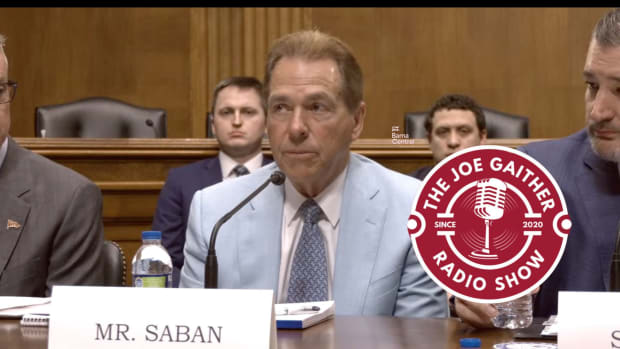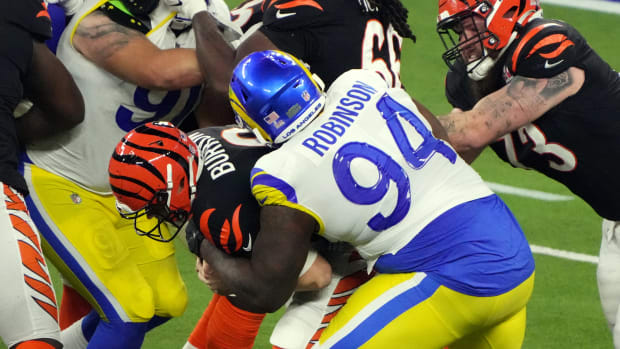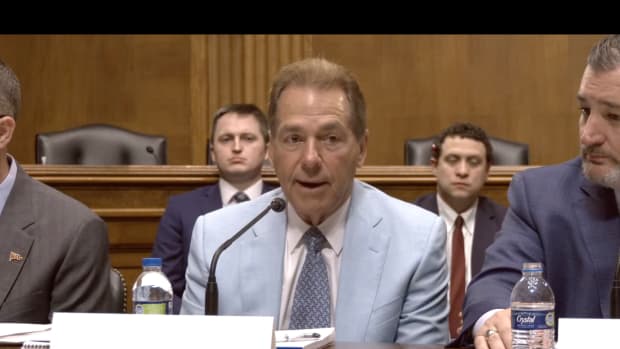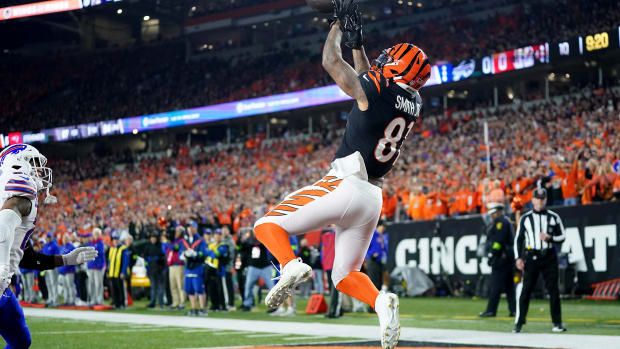Alabama SI Cover Tournament: Promised Land vs. The Tornado
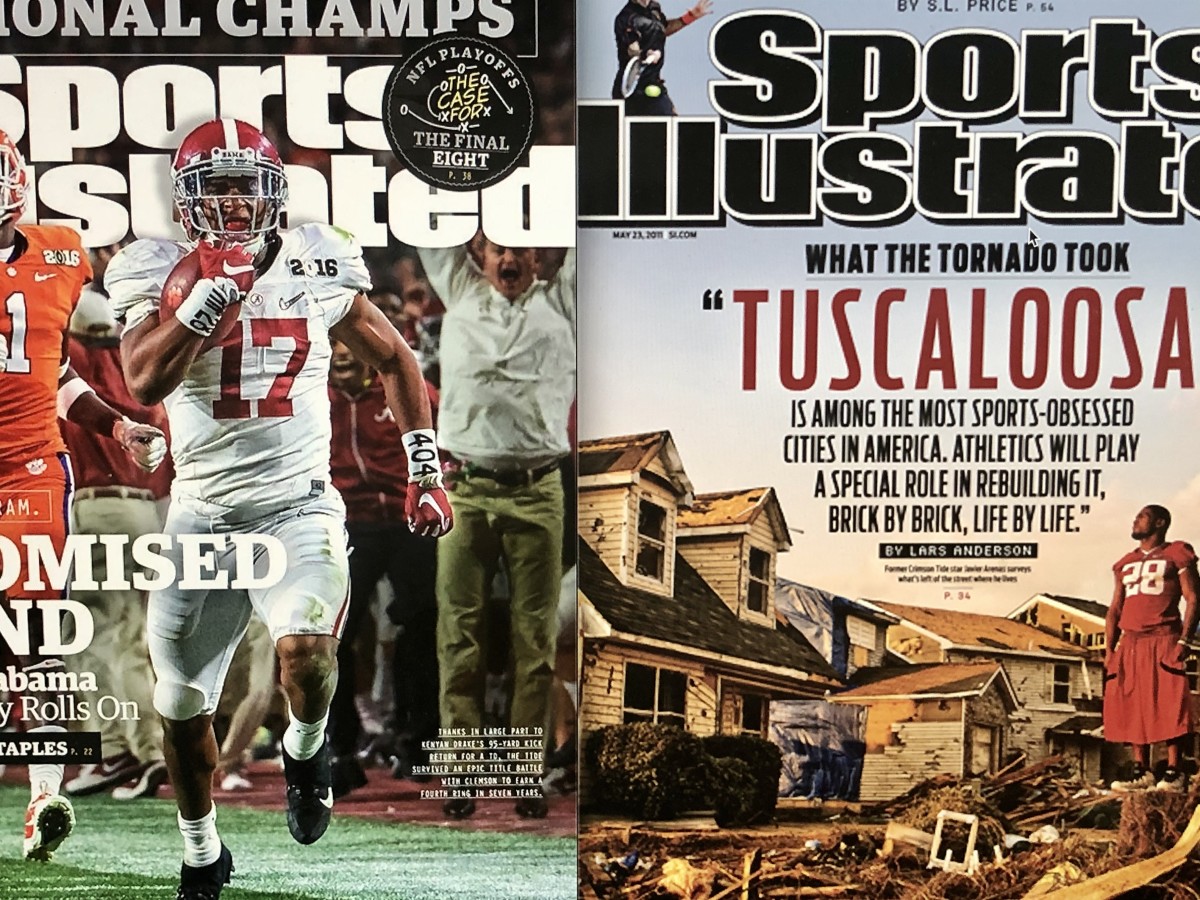
The final Sweet 16 pairing in the Alabama SI Cover Tournament features a pair of unforgettable moments in Crimson Tide history.
It's the Promised Land, the cover from Alabama's 2015 national championship victory over Clemson, against the 2011 tornado.
Only one will advance to the regional finals.
BamaCentral is holding a 48-field single-elimination tournament to determine the best Alabama Sports Illustrated cover.
Vote on Twitter (@BamaCentral) or Facebook (@AlabamaonSI). The voting goes 24 hours for each matchup and the result added to the original post on BamaCentral.
Sweet 16
All Things Bama Regional
Game 40: Promised Land (Kenyan Drake) vs. What the Tornado Took (Javier Arenas)
Promised Land: The Alabama Dynasty Rolls On
Story headline: This One Is Special
Subhead: An audacious onside kick. An electrifying kickoff return. A breakout by an underused tight end. Alabama needed something beyond its usual formula to hold off Clemson, but the end result was familiar: a fifth national title for coach Nick Saban
Excerpt (by Andy Staples): Nick Saban's game face typically ranges from stone to snarl, but the corners of his mouth turned north even as his team remained deadlocked with Clemson in the fourth quarter of Monday's national championship game. Was it relief? Joy? Or a knowing smirk?
At the team's hotel earlier in the day Saban had told Crimson Tide junior kicker Adam Griffith to be prepared to execute the pop kick onside protocol against the Tigers. Saban had noticed on film that when Clemson expected the ball to be booted deep into the corner, the Tigers squeezed to one side of the field. When Clemson lined up that way several times on Monday, Saban knew the pop kick could work — as long as freshman defensive back Marlon Humphrey, the play's target, didn't drop the ball the way he had in the Tide's walk-through practice. Tied at 24, with his defense panting from chasing Clemson sophomore quarterback Deshaun Watson — who was dazzling with 405 yards passing and 73 on the ground— Saban decided Alabama needed to gamble. "He pushed all the chips in," strength and conditioning coach Scott Cochran growled later.
Griffith tapped the ball skyward in a perfect arc. Humphrey, with nary a Clemson player in arm's distance, caught it on the 50, unleashing a (brief) grin from Saban. "He told us we're not allowed to smile during games," special teams coordinator Bobby Williams cracked. Two plays later senior quarterback Jake Coker hit junior tight end O.J. Howard down the left sideline for a 51-yard touchdown. The Tide had wrested the momentum away from a worthy opponent, and Alabama gutted out a 45-40 win to claim its fourth national title in seven seasons. Saban, who also won the 2003 title at LSU, moved one behind Bear Bryant, who won six championships. Saban brushed off questions about one day surpassing the Tide icon, but he couldn't hide his pride in a team that was written off in September but rose to win a title anyway, using a mix of new and old schemes and an attitude that has produced champions for as long as games have had scoreboards.
What the Tornado Took
Story headline: Terror, Tragedy and Hope in Tuscaloosa
Subhead: On April 27 the most devastating tornado in Alabama history cut nearly a mile-wide swath through the university town, killing 41. Crimson Tide athletes, haunted by the storm and its aftermath, work to heal a community that has always cheered them on as they try to put their own lives back together
Excerpt (by Lars Anderson): How do you tell the story of the deadliest tornado in the history of Alabama? As of Sunday, 41 were confirmed dead—including six students from the University of Alabama—and hundreds injured in Tuscaloosa and Tuscaloosa County alone. (A total of 238 people were killed by more than 60 tornadoes that ravaged the state on April 27.) But these raw numbers can't begin to account for the damage. Nearly every resident in the town of 90,000 has trouble sleeping, and when they do close their eyes and drift away, most are tormented by please-God-wake-me nightmares.
I live in Birmingham and from my front porch saw the same twister that decimated Tuscaloosa pass five miles to the north. Debris with Tuscaloosa markings—letters, business cards, pictures—fell in my neighborhood, which is 60 miles from T-town. My dreams, too, have been haunted by the images of destruction and despair I've seen in Tuscaloosa, where I taught a sportswriting class at the university this spring. None of my 14 students were physically harmed—though it took days of frantic texting and e-mailing to verify that as cellphones and Internet connections failed throughout Alabama—but the storm continues to swirl inside of them, deepening their emotional scars.
"The tornado cut a six-mile path through here that was a half mile to a mile wide," says Tuscaloosa mayor Walt Maddox as he looks at the ruins of a grocery store where his mother took him shopping as a boy. "Fifteen thousand people here were in the path of this thing. The enormity of it all can swallow you."
The most iconic structure in the state, Bryant-Denny Stadium, looms in the distance, dominating the battered T-town skyline. The tornado passed just a half mile south of the campus. "If it hits us," says Anthony Grant, the Crimson Tide men's basketball coach, "this place would have been shut down for several years. Who knows? Maybe longer."
Result
The initial vote ended in a tie. A runoff will be held over the July 4th weekend




